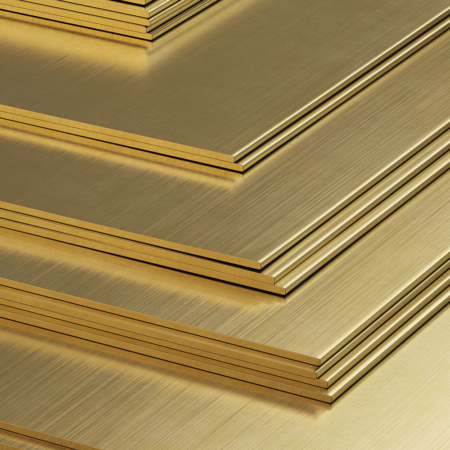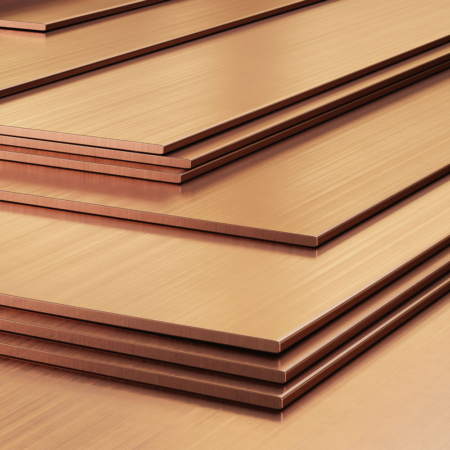Yellow Metals - Characteristics
| Spec. | Most Commonly Used Conditions | Description | Most Commonly Available Forms | Characteristics | Typical Uses |
|---|---|---|---|---|---|
| C101 | SOFT; HALF-HARD; HARD | Electrolytic tough pitch high conductivity copper | sheet, plate, bar & tube | High electrical conductivity and corrosion resistance. Ductile. Limited machining capabilities. | Electrical conductors, cold heading applications, holloware, architectural cladding. |
| C106 | HALF-HARD | Phosphorus deoxidised non-arsenical copper (Dona) | sheet, plate, tube | High phosphorus content reduces electrical conductivity, but greatly increases weldability in most forms. Ductile. Limited machinability. Good corrosion resistance. | Gas and heating installations, spinning, pressing, food processing equipment. |
| CZ101 | SOFT | Gilding metal | sheet | Very good corrosion resistance. Ductile. Very good for brazing and soldering, but limited machining capabilities. Attractive golden colour. | Jewellery, display cabinets, name plates, fascias. |
| CZ106 | SOFT | Deep drawing brass (cartridge brass) | sheet | Very ductile, especially where deep pressings need to be allied with strength. Very good for brazing and soldering, but limited machining capabilities. | Fire extinguisher bodies, lamp caps, hinges, flashlight cases. |
| CZ108 | HALF-HARD | Common' brass | sheet, plate, bar, tube, sections | General purpose brass with good ductility for bending and simple presswork. Good for brazing and soldering, but limited machining capabilities. | Instrument covers and containers, radiator tanks. |
| CZ112 | Naval brass | plate, bar | The addition of tin greatly improves corrosion resistance, especially in sea water. Good ductility if hot formed. Good for brazing and soldering, but with limited machining capabilities. | Marine and underwater equipment. | |
| CZ114 | High tensile brass (formerly manganese bronze) | bar | Combines high strenth with good corrosion resistance. Good ductility only if hot formed, good for soldering and brazing. Good machining capabilities. | Heavy engineering, shipbuilding | |
| CZ120 | HARD | Leaded brass engraving quality (compo) | sheet | Good machining capabilities. Produces a good clean cut in the hard condition for close tolerances. Ductile only if hot formed. Good for brazing and soldering. | Gears, clock parts, engraved plates. |
| CZ121-Pb3 | Free machining brass (CZ121-Pb4 for increased machining speeds) | bar, hollow bar & sections | Excellent high speed machining capabilities, but with limited cold working properties. Good for soldering and brazing. | Machined components such as screws, nut & bolts. Architectural sections. | |
| CZ126 | HALF-HARD, HARD | 70/30 arsenical brass | tube | General purpose brass with the addition of arsenic to reduce corrosion. | Condensers, heat exchangers, sanitary fittings. |
| CZ131 | Rivetting quality brass (supersedes CZ119) | bar | High copper content improves ductility, whilst reduced lead content still retains limited machining properties. Excellent for soldering. Good for brazing. | Cold heading products, rivets, screws, trye gauges. | |
| PB102 | HARD | Wrought phosphor bronze | sheet, bar | High strength, good resistance to corrosion and corrosion fatigue make this grade suitable for components subject to friction. Limited machining capabilities. | Springs and instrument components. |
| CA104 | Aluminium Bronze | bar | Addition of aluminium increases strength and greatly improves corrosion resistance. Good machining properties. Suitable for hot stamping. Readily welded via mig & tig. | Highly stresses bearings, and in the marine and chemical industries. | |
| SAE660 | Continuous cast leaded bronze | bar and cored bar | Suitable for unhardened shafts which are not subject to heavy side impact loads. Lead improves machining and plasticity. Will withstand some misalignment & short periods of inadequate lubrication. | Bearings for unhardened shafts. | |
| PB1 | Continuous cast phosphor bronze | bar and cored bar | The addition of tin improves corrosion resistance and strength. Designed for bearings running with hardened shafts where good lubrication and alignment are essential. | Bearings for hardened shafts. | |
| LPB1 | Continuous cast leaded phosphor bronze | bar and cored bar | The addition of lead increases plasticity & the reduction of tin lessens corrosion and abrasion resistance in this variant of PB1 | Lower stressed bearings and fitting such as valves. Steam pressure fittings. | |
| LB4 | Continuous cast leaded bronze | bar and cored bar | Suitable for unhardened shafts which are not subject to heavy side impact loads. Lead improves machining and plasticity. Will withstand some misalignment & short periods of inadequate lubrication. | Bearings for unhardened shafts. | |
| LG2 | Continuous cast leaded gun metal | bar and cored bar | A good general alloy. Suitable where corrosion resistance and resonable bearing characteristics, but at a lower cost, are important. | Marine industry. Some water and steam fittings, intricate tight pressure castings. |
Click here to learn more about Brass and Copper differences.

